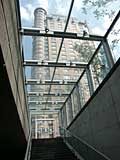7.3
Guide the development of the indoor pedestrian network
Montréal is one of many cities (Toronto, Calgary, Chicago, Minneapolis, Sydney) whose Centre is served by an indoor pedestrian network. Beginning in 1962 with the construction of a protected concourse between Central Station and the new shopping mall in Place Ville-Marie, Montréal's network has grown through the addition of various real estate developments in a unique spirit of public-private cooperation.
 The indoor network connects many large public, institutional, cultural, recreational and commercial buildings with metro and commuter train stations. Some sections also connect to complementary facilities, especially in the Quartier international de Montréal (hotels, international organizations, the World Trade Centre, Palais des Congrès). Pedestrians can walk through the Centre without worrying about extreme weather conditions or motor vehicle traffic.
The indoor network connects many large public, institutional, cultural, recreational and commercial buildings with metro and commuter train stations. Some sections also connect to complementary facilities, especially in the Quartier international de Montréal (hotels, international organizations, the World Trade Centre, Palais des Congrès). Pedestrians can walk through the Centre without worrying about extreme weather conditions or motor vehicle traffic.
Montréal's indoor pedestrian network generally runs below street level and has little negative impact on the built environment. This is a definite advantage over networks composed of numerous skywalks. However, it poses other difficulties. For instance, it can be disorienting to people who are unfamiliar with the City. Safety perceptions also vary according to the quality of the facilities (visibility, lighting, maintenance) and pedestrian volume.
Given the City's commitment to enhancing street life, considering its effect on urban revitalization, the expansion of the indoor pedestrian network must follow certain guidelines in order to control its impact on outdoor pedestrian traffic, retail activity or the development of unbuilt street-level lots. In light of this, the indoor pedestrian network requires a detailed planning process (see Section 4.23).
Implementation measures
- Set guidelines for the development of the indoor pedestrian network.
- Harmonize design and business hours across the various sections of the network.
- Ensure the universal accessibility of the network.
- Install uniform "RESO" signage
throughout the network in order to facilitate wayfinding (see Section 4.23).